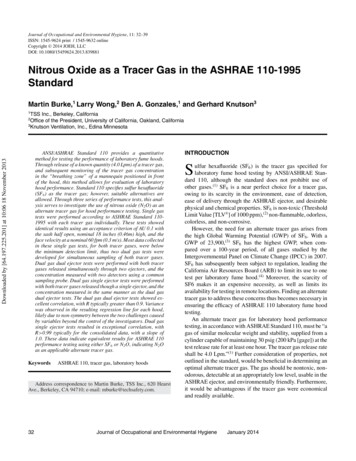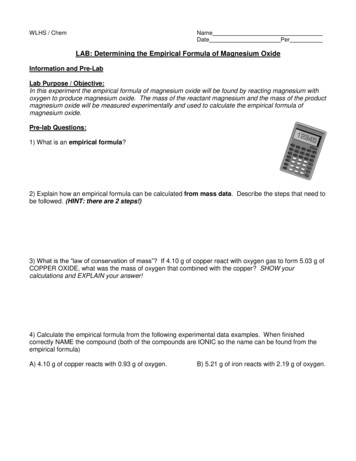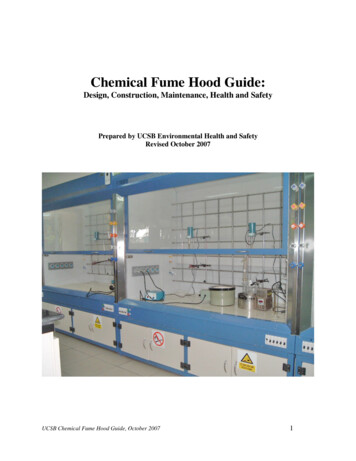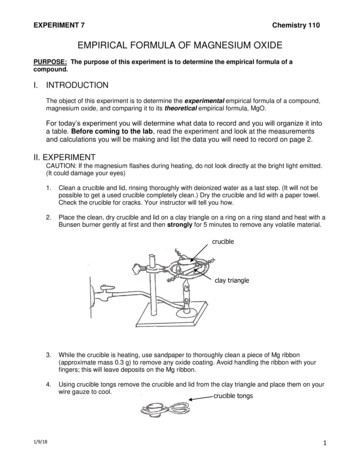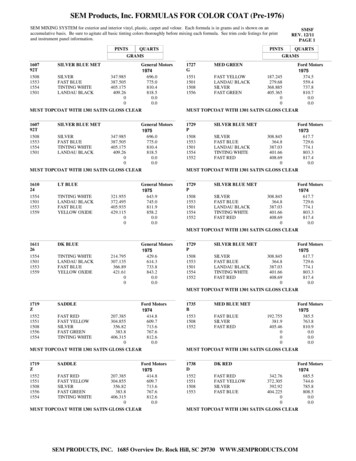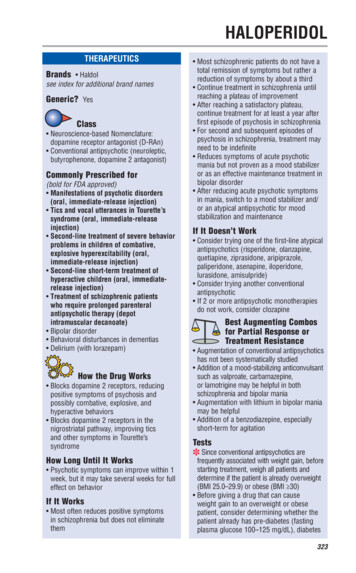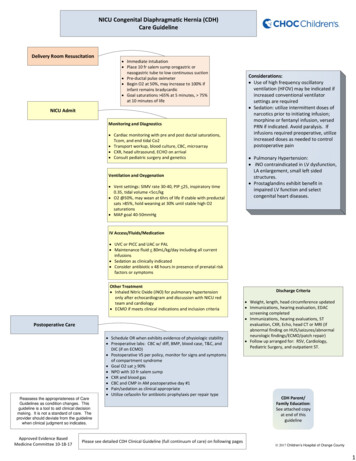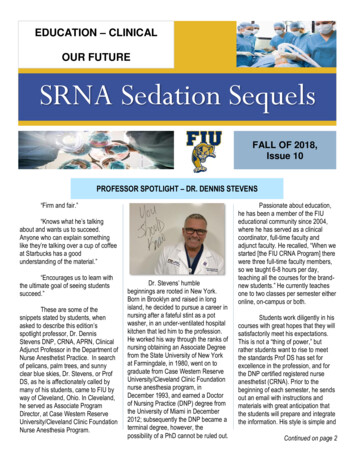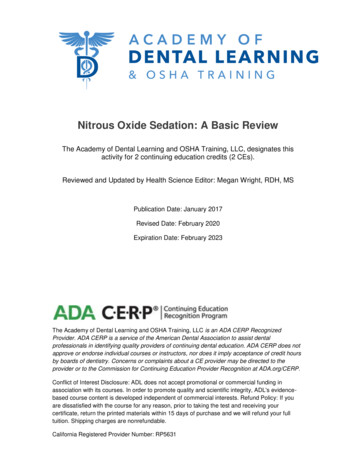
Transcription
Nitrous Oxide Sedation: A Basic ReviewThe Academy of Dental Learning and OSHA Training, LLC, designates thisactivity for 2 continuing education credits (2 CEs).Reviewed and Updated by Health Science Editor: Megan Wright, RDH, MSPublication Date: January 2017Revised Date: February 2020Expiration Date: February 2023The Academy of Dental Learning and OSHA Training, LLC is an ADA CERP RecognizedProvider. ADA CERP is a service of the American Dental Association to assist dentalprofessionals in identifying quality providers of continuing dental education. ADA CERP does notapprove or endorse individual courses or instructors, nor does it imply acceptance of credit hoursby boards of dentistry. Concerns or complaints about a CE provider may be directed to theprovider or to the Commission for Continuing Education Provider Recognition at ADA.org/CERP.Conflict of Interest Disclosure: ADL does not accept promotional or commercial funding inassociation with its courses. In order to promote quality and scientific integrity, ADL's evidencebased course content is developed independent of commercial interests. Refund Policy: If youare dissatisfied with the course for any reason, prior to taking the test and receiving yourcertificate, return the printed materials within 15 days of purchase and we will refund your fulltuition. Shipping charges are nonrefundable.California Registered Provider Number: RP5631
Answer Sheet: Nitrous Oxide Sedation: A Basic Review1.6.2.7.3.8.4.9.5.10.Name: Profession:License State: License Number: Expiration DateAddressCity: State: Zip Code:Telephone: Fax:E-mail:If you have downloaded the course and printed the answer sheet from the Internet please enterpayment information below.Card type: Card Number:Exp. Date: Name as it appears on card:*To enter your answers online you MUST return to our website www.dentallearning.org.Return answer sheet: Via fax: 518.514.1103Via email: CESupport@dentallearning.comPostal Mail: ADL, PO Box 14585, Albany, NY 12212***PLEASE PRINT CLEARLY; ILLEGIBLE ANSWER SHEETS WILL NOT BEPROCESSED.Notes:1
Course EvaluationPlease place an X in the box to rate thesestatements:PoorFairGoodVeryGoodExcellentThe content fulfills the overall purpose of the course.The content fulfills each of the course objectives.The course subject matter is accurate.The material presented is understandable.The teaching/learning method is effective.The answers to the test questions are appropriatelycovered in the course.How would you rate this course overall?Hours:Time to complete the entire course and the test?Minutes:GoogleOther Search EngineFriend/CoworkerOtherDo you have any suggestions about how we can improve this course? If so please note them on aseparate sheet of paper and send it in with your answer sheet.If you studied the course online, did all the links work? If not please note the page and link on a separatesheet of paper and send it in with your answer sheet so we can fix it.2
Instructions1. Review the Objectives: Objectives provide an overview of the entire course.2. Read the course material.3. Complete the test:a. Return to our website: www.dentallearning.org, click on Take the Exam,enter your answers, register, if you are new customer (existing customerslogin), pay for the course, click Grade Test. Your test will be gradedimmediately. If required, complete the course evaluation. Your certificatewill display for you to print.b. If you would rather, you may return your completed answer sheet andcourse evaluation to us via the options listed below.To successfully complete the course you must score 80% or above on the test. If youdo not score 80% you may retake the test one more time free of charge. If you fail asecond time you must purchase a new course and test.If you’ve downloaded this coursebook off the Internet you can: Return to our website (www.dentallearning.org) to take the test online (only if youhave not purchased the coursebook separately). You will need to provide creditcard information at the time you submit your test online for scoring. Write your answers on the one-page answer sheet included in this book,complete the credit card payment information, and return the form to the addressbelow, fax, or email address below. Or, you may send a check or money order tothe address below with your answer sheet.Academy of Dental Learning and OSHA Training, LLC (ADL)P.O. Box 14585Albany, NY 12212Fax: 518-514-1103Email: CESupport@dentallearning.orgAnswer sheets received without payment will not be processed.We grade all tests in a timely manner; if you do not receive your certificate within fivedays, please email (CESupport@dentallearning.org) or call us: 518-209-9540.There is no time limit for return of your answer sheet. Completion dates are taken fromthe envelope postmark or the finish date recorded in the computer when you do anonline exam. Tests MUST be completed in the licensing cycle you wish to use thecredits.If you are dissatisfied with the course for any reason, prior to taking the test andreceiving your certificate, return the printed materials within 15 days of purchase and wewill refund your full tuition. Shipping charges are nonrefundable.3
If someone else would like to use this material after you are done, he or she mayregister with us and take advantage of a “sharing discount”. Courses downloaded fromthe Internet can be shared at the same tuition rate as currently available on our website.Please call us if you need an extra answer sheet or download one from our website.There is no “sharing discount” for online exams.The author and ADL have made every effort to include information in this course that isfactual and conforms to accepted standards of care. This course is not to be used as asole reference for treatment decisions. It is your responsibility to understand your legalobligations and license requirements when treating patients. ADL is not responsible forthe misuse of information presented in this course. The material in this course cannotbe reproduced or transmitted in any way without the written consent of ADL.4
Table of ContentsAnswer SheetEvaluationInstructionsTable of ContentsObjectivesIntroductionHistory of Nitrous Oxide and Use in DentistryProperties and Mechanism of ActionUses in Clinical DentistryEquipmentEngineering Controls and Maintenance ProceduresPre-clinical and Post-clinical Work PracticesVarious Side Effects of Nitrous Oxide/Oxygen InhalationWorkplace Safety Information from OSHA and NIOSHAbuse of Nitrous OxideUpdates on N2OConclusionReferencesGlossary of TermsCourse Test51235667891011141619242426262832
ObjectivesUpon completion of this course, the student will be able to: Understand the history and background for Nitrous Oxide as an anestheticagent.Identify indications for use in clinical dentistry.Identify contraindications for use in clinical dentistry.Evaluate patients suitable for nitrous oxide sedation.Know the basic equipment and its use in the dental operatory.Understand best clinical practices for nitrous oxide sedation.Implement workplace monitoring and safety guidelines per OSHA guidelines.Identify signs and symptoms of exposure.Understand nitrous monitoring systems, i.e. Laudauer Monitoring Badge.Maintain absolute safety for patients in the clinical setting.IntroductionClinical dentistry often needs chemical agents to maintain patient comfort and to allayanxiety (anxiolytic properties). The ideal agent would have a fairly rapid onset of action,good therapeutic effectiveness, a wide safety margin, quick recovery time, no“hangover” effect or excessive sedative effects, and which does not require thepresence of an anesthesiologist.An anesthetic which is ideally suited to clinical dentistry is nitrous oxide or N2O asnitrous oxide is commonly abbreviated. Nitrous oxide produces analgesic and anxiolyticeffects when used correctly in a clinical setting. Nitrous oxide (N20 on many forms orchemical symbol N2O) gas has been available to the medical and dental community forover 150 years. The use of nitrous oxide as an anesthetic is common foranesthesiologists and dental practitioners as an adjunct to local anesthetic agents, andfulfills almost all of the criteria listed above.This course reviews the general use of nitrous oxide for the dental practitioner anddental staff. The course emphasizes best clinical practices to support absolute patientsafety and to assure that clinicians minimize exposure to themselves in the workplace.OSHA sets forth specific guidelines for clinical and workplace safety which will bediscussed in detail. Also a review of common terms is provided as an appendix, aswell as information about workplace safety and monitoring systems for exposuremanagement in the dental clinical setting. Ironically, nitrous oxide exposure issues forthe patient are relatively minimal. Of more concern are the long-term health issues forclinicians, particularly child bearing age women, who may be exposed on a daily basisand therefore subject to more cumulative effects based on the frequency of exposure.6
History of Nitrous Oxide and Use in DentistryNitrous oxide, one of the first modern anesthetics, was first manufacturedin 1772 by English chemist, Joseph Priestly. About 1800, Sir HumphreyDavy experimented with the physiological properties of the gas andstated: “As nitrous oxide in its extensive operation appears capable ofdestroying physical pain, it may probably be used with advantage duringsurgical operation”. The surgical world ignored his suggestion, andinterest in the surgical use of nitrous oxide would have to wait anotherhalf century. After Sir Davy observed the amusing effects on people who inhalednitrous oxide, he coined the term “laughing gas” which is also commonly used today.Nitrous oxide was used for the first time as a dental anesthetic drug in 1844. Dr. HoraceWells, with assistance by Gardner Quincy Colton and John Mankey Riggs, collaboratedsuccessfully to use nitrous oxide on a patient for an extraction. In the followingweeks, Wells treated the first 12-15 patients with nitrous oxide, and according to hisown record only failed in two cases. In spite of these convincing results reported byWells to the medical society in Boston, this new method of pain management was notimmediately adopted by other dentists. In early 1845, Wells’ first public demonstration ofnitrous oxide anesthesia for the medical faculty in Boston, was only partly unsuccessful,leaving his colleagues doubtful regarding its efficacy and safety. Wells was booed offthe stage and in the aftermath, he lost his reputation and eventually committed suicide.However, to this day, Dr. Wells is considered the “discoverer of anesthesia”.In 1863 nitrous oxide anesthesia came into general use, when Gardner Quincy Coltonsuccessfully began to use nitrous oxide in all his “Colton Dental Association”clinics. Up to the 1860’s nitrous oxide was used alone as an inhalational anesthetic with100% concentration of the gas administered to patients. Oxygen was added to the gasmix, and soon Colton and his associates successfully administered nitrous oxide tomore than 25,000 patients, with over75,000 extractions completed with the use of N2O as an anesthetic. Now with theefficacy and safety demonstrated by large numbers of successful procedures, the use of7
nitrous oxide rapidly became the preferred anesthetic method in dentistry. The gas ismild enough to keep a patient in a conscious and conversational state, and in mostcases is strong enough to suppress the pain caused by dental procedures. Therefore,nitrous oxide remains today as the preferred anesthetic gas used in dentistry.Every year approximately 45 million dental patients undergo anesthesia in NorthAmerica, with nitrous oxide constituting a major component in about half of theseprocedures. A significant percentage of general dentists use nitrous oxide sedation intheir practices to manage pain, anxiety, and excessive gag reflex. Nitrous is themost used gaseous anesthetic in the world, commonly administered for thepurpose of decreasing the amount of more potent and usually more toxic agentsduring general anesthesia cases.Properties and Mechanism of ActionNitrous oxide produces analgesic (pain killing) and anxiolytic(anxiety reduction) effects. Nitrous oxide is the weakest of theinhalant anesthetics used for patient sedation in dentistry ormedicine. The chemical formula is N2O. The gas is colorless,non-flammable, with a slightly sweet odor.Nitrous oxide has low solubility in blood, diffuses rapidly across the alveolar-arterialmembrane and is excreted unchanged through the lungs. As a result, nitrous takeseffect rapidly and is quickly reversible on discontinuation. Nitrous oxide can induce lossof consciousness at high concentrations, typically 70% or higher. Nitrous oxideproduces either no change, or a slight increase in blood pressure, while all other volatileanesthetics reduce blood pressure. There is no effect on heart rate, but high doses maycause myocardial depression.The exact mechanism of action is unknown. However, the mostwidely accepted theory is that the analgesic effect is occurs byinteraction with the opioid receptors. These are the same receptorsactivated by morphine and heroin. This stimulation occurs in themid-brain leading to activation of the descending inhibitory pathways,which alters pain processing in the spinal cord. The anxiolytic effectis mediated by interaction with the GABA-A receptors. Themechanism of action closely resembles that of ethanol. GABA is an inhibitoryneurotransmitter that inhibits the pre-synaptic cells from transmitting thus decreasingnervous system activity.Nitrous oxide gas is used in both the medical and dental professions to ensure patientcomfort during procedures. A 40%-70% N2O mixture (the remainder consisting ofoxygen) is used as an adjunct to inhalation and IV general anesthesia. The gaseous8
mixture is administered using either a mask, nasal canula, or an endotracheal tube.The onset of action for N2O is between 2-5 minutes. However, since the mean alveolarconcentration (MAC) of N2O considered the ED50 for general anesthesia (the dose atwhich 50% of patients will experience anesthesia) is 105%, nitrous cannot be usedalone as a general anesthetic. Typically, nitrous oxide is only used to start theanesthesia process.In dentistry, nitrous oxide is typically used as an anxiolytic or as an anxiety reducingagent. N2O is given as a 25%-50% mixture with oxygen. Most often it is administeredthrough a nasal mask or nasal canula.The patient should be started out breathing 100% oxygen and then slowly allowed tobreathe increasing amounts of N2O until the desired effect is achieved. It is importantthat the patient be reminded to breathe through the nose in order for the gas to work.The patient should be questioned as to how they are feeling to ensure an optimal levelof nitrous is being administered. Therapeutic levels will vary from patient to patient. Ifthe nitrous level being administered is too low, the patient will not be receiving aneffective anxiolytic dose. If the nitrous level is too high, unwanted side effects mayoccur. After the procedure is finished, allow the patient to breathe 100% oxygen againfor 2-5 minutes in order to clear the nitrous from the lungs and return the patient to apre-anesthetic state or normal feeling.Uses in Clinical DentistryIndications A fearful, anxious, or obstreperous patientCertain patients with special health care needsA patient whose gag reflex interferes with dental careA patient for whom profound local anesthesia cannot be obtainedA cooperative child undergoing a lengthy dental procedure9
Contraindications Some chronic obstructive pulmonary diseasesSevere emotional disturbances or drug-related dependencies (see abuse)First trimester of pregnancyTreatment with bleomycin sulfateMethylenetetrahydrofolate reductase deficiency (B12)The contraindications for use of nitrous are important especially when considering thatnitrous oxide is the only inhaled anesthetic proven to be teratogenic (causing birthdefects) in animals, so is to be avoided in the first trimester of pregnancy. Patients withpulmonary hypertension or major cardiac disease should be evaluated carefully and inconsultation with the medical doctor before using nitrous. Patients with severelycompromised cardiac function are not candidates for nitrous oxide sedation because ofthe slight myocardial depressant action of the gas on the circulatory system. Andpatients who are claustrophobic may be unable to tolerate a nasal mask although use ofa nasal canula may solve the issue. Some patients may fear “losing control” ofthemselves and adamantly refuse N2O sedation. Patients with persistent nasalcongestion or obstruction or who unable to breathe comfortably through the nose, maynot be candidates for nitrous oxide sedation.Review of patient’s current medical history is critical prior to the decision to use nitrousoxide sedation and a medical consultation with the patient’s physician may benecessary. This assessment should include: Allergies and previous allergic or adverse drug reactionsCurrent medications including dose, time, route, and site of administrationDiseases, disorders, or physical abnormalities and pregnancy statusPrevious hospitalization to include the date and purposeObtain written consent from patient or the guardian of a minor patient.EquipmentMixtures of N2O and oxygen have been used in dentistry as general anesthetic agents,analgesics, and sedatives for more than 100 years. The usual analgesia equipmentused by dentists includes a N2O and O2 delivery system, a gas mixing bag, and a nasalmask or nasal canula with a positive pressure relief valve.10
Figure one below shows basic N20 equipment set up and arrows represent possibleleakage areas, discussed below.Engineering Controls / Maintenance ProceduresThe following engineering controls and maintenance procedures have been shown tobe feasible and effective in reducing workplace exposure to N2O during anestheticadministration.Figure 1 illustrates sources of possible leaks from anesthetic delivery systems in dentaloperatories. These sources include leaks from the high-pressure connections present inthe gas delivery tanks, the wall connectors, the hoses connected to the anestheticmachine, and the anesthetic machine (especially the on-demand valve). Low-pressureleaks occur from the connections between the anesthetic flowmeter and the scavengingmask. This leakage is due to loose- fitting connections, loosely assembled or deformedslip joints and threaded connections, and defective or worn seals, gaskets, breathingbags, and hoses.All newly installed dental facilities that deliver nitrous oxide/oxygen must be checked forproper gas delivery and fail-safe function prior to use. Inhalation equipment must havethe capacity for delivering 100%, and never less than 30%, oxygen concentration at aflow rate appropriate to the child’s or adult’s size. Additionally, inhalation equipmentmust have a fail-safe system that is checked and calibrated regularly according to thedental practitioner’s state laws and regulations. All nitrous oxide delivery system11
equipment must have an appropriate scavenging system.The dental clinician, who utilizes nitrous oxide/oxygenanalgesia for a pediatric or general practice dental patient,shall possess appropriate training and skills and haveavailable the proper facilities, personnel, and equipment tomanage any reasonably foreseeable emergency. Trainingand certification in basic life support are required for allclinical personnel and per state regulation. These individuals should participate inperiodic review of the office’s emergency protocol, the emergency drug cart, andsimulated exercises to assure proper emergency management response. Ideally thedental team meets regularly to review clinical emergency management protocols. Alldental personnel need current CPR and basic life support training.An emergency cart (kit) must be readily accessible. Emergency equipment must be ableto accommodate adults and children of all ages and sizes. It should include equipmentto resuscitate a non-breathing, unconscious patient and provide continuous support untiltrained emergency personnel arrive.A positive pressure oxygen delivery system capable of administering 90% oxygen at a 10 liters/minute flow for at least 60 minutes (650liters, “E” cylinder) must be available. When a self-inflating bag valvemask device is used for delivering positive pressure oxygen, a 15liters/minute flow is recommended. There should be documentation thatall emergency equipment and drugs are checked and maintained on aregularly scheduled basis. Where state law mandates equipment andfacilities, such statutes should supersede this guideline.Analgesia machines for dentistry are designed to deliver up to 70 percent (700,000ppm) N2O to a patient during dental treatment. The machine restricts higherconcentrations of N2O from being administered to protect the patient from hypoxia (lackof oxygen). In most cases, patients receive between 30 and 50 percent N2O during aprocedure. The amount of time N2O is administered to a patient depends on thedentist’s judgment of an individual patient needs and the complexity of the case.A newer type of mask is a frequent choice in dental practice: asingle patient use nasal hood or single use nasal canula. Thissingle use mask or canula does not require sterilization aftersurgery because it is used once and is disposable.In a dental operatory, a scavenging system is part of a high-volume evacuation systemused with a dental unit. The vacuum system may dispose of a combination of wastegases, oral fluid, and debris, and is not limited to waste gas removal. The exhaust air of12
the evacuation system should be vented outside the building and away from fresh-airinlets and open windows to prevent re-entry of gas into the operatory.Scavenging SystemA scavenging system designed to pick up excess gases consists of five basiccomponents:1.2.3.4.5.Gas collection assembly which captures excess anesthetic gases at the siteof emission, and delivers it to the transfer tubing.Transfer tubing: conveys the excess anesthetic gases to the interface.The interface: provides positive (and sometimes negative) pressure reliefand may provide reservoir capacity. It is designed to protect the patient’slungs from excessive positive or negative scavenging system pressure.Gas disposal assembly tubing: conducts the excess anesthetic gases fromthe interface to the gas disposal assembly.Gas disposal assembly: conveys the excess gases to a point where theycan be discharged safely into the atmosphere. Several methods in useinclude a non-recirculating or recirculating ventilation system, a centralvacuum system, a dedicated (single-purpose) waste gas exhaust system, or apassive duct system.13
Circle breathing system connected to a closed reservoir scavenging interface. (Reproduced bypermission of North American Dräger, Telford, Pennsylvania).The general ventilation should provide good room / air mixing. In addition, auxiliary(local) exhaust ventilation should be used in conjunction with a scavenging system andhas been shown to be effective in reducing excess N2O in the breathing zone of thedental professional/s, from nasal mask leakage and patient mouth breathing. This typeof ventilation captures the waste anesthetic gases at their source. However, there arepractical limitations in using it in the dental operatory. These include proximity to thepatient, interference with dental practices, noise, installation and maintenance costs. Itis most important that the dentist not work between the patient and a free-standing localexhaust hood. Doing so will cause the contaminated air to be drawn through thedentist’s breathing zone.Pre-clinical and Post-clinical Work Practices Prior to first use each day of the N2O machine and every time agas cylinder is changed, the low-pressure connections should betested for leaks. High-pressure line connections should be testedfor leaks quarterly. A soap solution may be used to test for leaksat connections. Alternatively, a portable infraredspectrophotometer can be used to detect an insidious leak.Prior to first use each day, inspect all N2O equipment (e.g.,reservoir bag, tubing, mask, connectors) for worn parts, cracks,holes, or tears. Replace as necessary. Connect mask to thetubing and turn on vacuum pump. Verify appropriate flow rate (i.e., up to 45L/min or manufacturer’s recommendations). A properly sized mask should be selected and placed on thepatient. A good, comfortable fit should be ensured. Thereservoir (breathing) bag should not be over or under-inflatedwhile the patient is breathing oxygen (before administeringN2O).14
Encourage the patient to minimize talking, mouth breathing, and facialmovement while the mask is in place.During N2O administration, the reservoir bag should be periodically inspectedfor changes in tidal volume, and the vacuum flow rate should be verified.On completing anesthetic administration and before removing the mask, nonanesthetic gases/agents should be delivered to the patient for a sufficient timebased on clinical assessment that may vary from patient to patient. In thisway, both the patient and the system will be purged of residual N2O. Do notuse an oxygen flush.Clinical ProtocolsSome dentists administer N2O at higher concentrations at the beginning of theprocedure, and then decrease the amount as the procedure progresses. Othersadminister the same amount of N2O throughout the procedure. When the procedure iscompleted, the N2O is turned off. Some dentists turn the N2O on only at the beginningof the operation, using N2O as a sedative during the administration of local anesthesia,and turn it off before operating procedures. Based on variations in dental practices andother factors in room air, N2O concentrations can vary considerably for each operationand also vary over the course of the dental procedure.In the typical dental office procedure, the nasal mask or nasal cannula is placed on thepatient, fitted, and adjusted prior to administration of the nitrous oxide/ oxygen gases.The mask or cannula is designed for the nose of the patient since access to thepatient’s mouth is essential for dental procedures.A local anesthetic, if needed, is typically administered after the N2O takes effect. Thepatient’s mouth is opened and the local anesthetic is injected. The dental procedurebegins after the local anesthetic takes effect. The patient opens his/her mouth but isinstructed to breathe through the nose. Nonetheless, a certain amount of mouthbreathing frequently occurs. The dentist may periodically stop the dental procedure for amoment to allow the patient to close the mouth and breathe deeply to re-establish anappropriate concentration of N2O in the patient’s body before resuming the procedure.Depending on the nature of the procedure, high velocity suction is regularly used toremove intra-oral debris and, when used, creates a negative air flow and captures someof the gas exhaled by the patient.At the end of the procedure, the nosepiece is left on the patient while the N2O is turnedoff and the oxygen flow is increased. The anesthetic mixture diffuses from thecirculating blood into the lungs and is exhaled. Scavenging is continued while thepatient is eliminating the N2O.15
Protocols for Monitoring the PatientThe response of patients to commands during procedures performed during nitrousoxide anesthesia serves as a guide to their level of consciousness. Clinical observationof the patient must be done during any dental procedure. During nitrous oxide/oxygenanalgesia, continual clinical observation of the patient’s responsiveness, color, andrespiratory rate and rhythm must be performed. Spoken responses provide an indicationthat the patient is breathing. If any other pharmacologic agent is used in addition tonitrous oxide/oxygen and a local anesthetic, monitoring guidelines for the appropriatelevel of sedation must be followed.The use of a pulse oximeter is also indicated. The oximeter measures the amount ofoxygen saturation in the bloodstream via a sensor device placed on a finger or in thecase of an infant, on a foot. If the reading falls below 90%, the attending dentalpersonnel need to increase oxygen by increasing flow by making sure the airway isunobstructed and that the patient is breathing deeply enough to maintain appropriatelevels. Pulse oximeters are relatively inexpensive and are extremely helpful inmonitoring the patient during nitrous oxide administration. Most pulse oximeters have asound notification if the oxygen saturation in the blood falls below 90%.Side Effects of Nitrous Oxide / Oxygen InhalationThe side effects of N2O take three main forms:1.2.3.Metabolic inhibitionPressure/volume problemsProblems related to the administration of oxygen.Metabolism of Nitrous OxideNitrous oxide irreversibly oxidizes the cobalt atom of vitamin B12, inhibiting the activityof the cobalamin-dependent enzyme methionine synthase. Synthesis of the enzyme isrequired to restore activity and takes several days. A 50% decrease in methioninesynthase activity is seen after only 2 hours of exposure. Loss of this enzyme shuts off16
the synthesis of methionine, a principle substrate for assembly of myelin sheaths andDNA synthesis, and leads to an accumulation of its precursor homocysteine. In adultswith untreated B12 deficiency exposed to nitrous or those who chronically abuse N2Oleading to depletion of body stores of cobalamin, a myeloneuropathy is seen which isidentical to subacute combined degeneration of the spinal column as seen in perniciousanemia. A high degree of suspici
nitrous oxide rapidly became the preferred anesthetic method in dentistry. The gas is mild enough to keep a patient in a conscious and conversational state, and in most cases is strong enough to suppress the pain caused by dental procedures. Therefore, nitrous oxide remains
